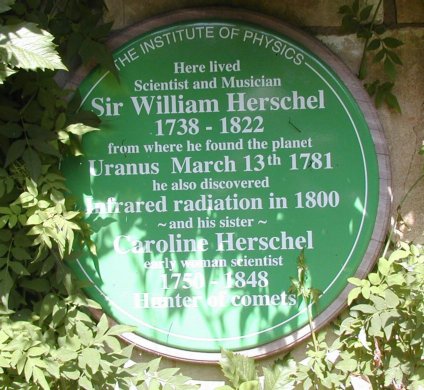German born astronomers who came to live in Bath and later moved to Slough


Caroline Herschel was born on 16 March 1750 into a large Hanoverian society family. Her father Isaac introduced her to the wonders of his pet hobby, astronomy although her mother believed that it was Caroline’s duty to be fully occupied with household matters. When her elder brother William moved to England and established himself as an organist and music teacher he eventually persuaded their mother to allow Caroline to join him so that she could train as a singer.
Caroline joined William in 1772. William was also a keen amateur telescope maker and observer and as his interest in astronomy flourished, so did Caroline’s. She learned enough of maths and calculation methods to be able William to write his research results. Her intended singing career receded and she became his assistant in the workshop, helping to grind and polish his mirrors and writing down the observations made through his telescope.
William was appointed Court Astronomer in 1784 and with his new wealth waspreviously listed. William added them to his list but credited Caroline with their discovery.
In 1786 William set Caroline up with her own observatory. Caroline became an expert in the observation of what we now call deep-sky objects, cataloguing in all no fewer than 2500 nebulae. An award of £50 from George III recognised her work as William’s assistant - the first official female assistant to the Court Astronomer.
Caroline made another major contribution to astronomy by updating the star catalogue drawn up by John Flamsteed, the first Astronomer Royal, which has been considered the ‘astronomer’s bible’. She completed the long and arduous task in 1798 and her book and index was published by the Royal Society.
When William married Mary Pitt in 1788 Caroline’s lifestyle changed but she remained devoted to him and his work and also took great interest in their son John (born in 1792 and himself destined to become a famed astronomer and physicist). When Sir William Herschel died in August 1822 Caroline felt that her world had come to an end. The following year she returned to Hanover to look after her younger brother Dietrich, but remained busy with her astronomical labours. She prepared a fresh catalogue of nebulae arranged into zones. This ‘Zone Catalogue’ represents her last major personal contribution to astronomy and was published by order of the Royal Society.
In Caroline’s later years, many honours were bestowed on her. In 1828, she was awarded the Gold Medal of the Royal Astronomical Society. In 1835 she was one of the first two women created an Honorary Fellow of the Royal Astronomical Society. In 1846, in honour of her 96th birthday, the King of Prussia sent her the Gold Medal for Science. In 1847, the Crown Prince and Princess of Hanover came personally to give her a birthday present - a large velvet armchair. She was as mentally alert as ever and kept her royal guests entertained for two hours. On 9 January 1848, she died peacefully in her sleep at the age of 97
Further information:
Page last updated 26 July 2014